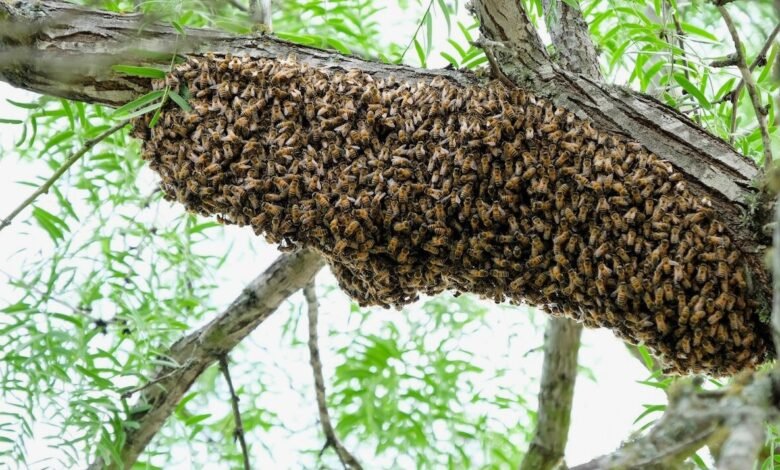
Bees are incredibly fascinating creatures, known for their complex social structures and highly coordinated behaviors. One of the most intriguing aspects of their behavior is how they select a new home for their hive. It’s not uncommon for homeowners to discover bee colonies in unexpected places, such as attics, chimneys, or even within the walls of their homes. These locations may seem odd to us, but they provide an ideal environment for bees to thrive. Understanding the science behind hive behavior can shed light on why these intelligent insects choose such unlikely spots, revealing the factors that influence their decisions and how they impact homeowners.
What Drives Hive Behavior?
Hive behavior in bees is driven primarily by survival instincts and environmental conditions. Honeybees, in particular, follow a highly coordinated process when seeking a new location for their hive. A colony typically chooses a new home when it has outgrown its current one or when it needs to relocate due to environmental factors.
Several factors influence hive behavior, such as temperature regulation, safety, and access to food. These priorities shape where bees decide to set up their hive, often leading them to unlikely spots that seem inconvenient to humans but are ideal for the bees.
Temperature Control and Hive Location
One of the main reasons bees choose locations like attics or chimneys is temperature control. Bees are incredibly sensitive to temperature and need to maintain the hive at a consistent internal temperature to protect their brood and honey stores. Spaces like attics provide an insulated, stable environment that remains warm enough during cooler months and shaded during hotter months, making it an ideal location for a hive.
This instinctual behavior is part of the broader scope of hive behavior, where bees prioritize temperature consistency to ensure the colony’s survival and growth. This trait makes attics and chimneys particularly appealing to bees, who seek out naturally sheltered locations.
Role of Scout Bees in Hive Selection
Before bees settle in a new location, scout bees play a crucial role in searching for the ideal spot. These scouts fly out from the colony, searching for potential nesting sites that meet the colony’s needs. They assess a variety of factors, such as the space’s size, entrance accessibility, and how protected it is from predators.
Scout bees will often return to report their findings through a unique dance, known as the “waggle dance.” This form of communication provides the rest of the colony with detailed information on the location of possible new homes, and the most promising site is eventually chosen by consensus.
Attics and chimneys often rank highly in this process because they meet many of the key criteria that scout bees are looking for, including shelter from the elements and minimal disturbance from human activity.
Protection from Predators
Another important factor in hive behavior is safety from predators. Bees instinctively seek out locations that will offer protection from potential threats like birds, other insects, or even small mammals. Chimneys and wall cavities often provide these features. These spaces are elevated and enclosed, creating a natural barrier that deters predators while allowing the bees to thrive undisturbed.
This aspect of hive behavior underscores why bees are so frequently found in places that seem inconvenient to homeowners, such as inside wall cavities, under roof eaves, or even between floors. Their behavior is driven by an instinctual need to ensure the survival of the colony.
Why Bees Choose Chimneys and Attics
Chimneys and attics may seem like unlikely choices for a hive to humans, but they provide a perfect combination of seclusion, insulation, and space. Chimneys, in particular, offer tall, vertical structures that are similar to hollowed-out trees, which are bees’ natural nesting sites in the wild. The enclosed walls provide bees with a safe and temperature-controlled environment where they can build and expand their hive without outside interference.
Attics provide an additional layer of insulation, making it easy for bees to regulate the internal hive temperature, especially in areas with fluctuating weather conditions. In regions like Orange County, where temperatures can vary greatly between seasons, attics offer a relatively consistent environment that helps bees thrive year-round.
Environmental Factors and Human Structures
Beehive behavior is influenced by more than just the physical characteristics of a location. Environmental factors like changes in weather patterns, human construction, and loss of natural habitats can also force bees to adapt and find new nesting places. As natural nesting spots become scarce due to urbanization, bees are increasingly drawn to human-made structures like houses and buildings.
This behavior is becoming more common, particularly in urban and suburban environments where natural options are limited. In these cases, professional services like bee hive removal in Orange County offer a safe solution for homeowners and bees alike. Removing and relocating the hive safely ensures that the colony can continue its vital role in pollination without disrupting human activities.
Seasonal Patterns in Hive Behavior
Hive behavior also changes throughout the seasons. In spring and early summer, colonies are most likely to split through a process known as swarming. During this time, the queen and a portion of the colony leave the original hive in search of a new nesting site. This is when many homeowners start noticing bee activity in their chimneys, attics, or walls.
As bees prepare for winter, they become even more selective about where they build their hive, focusing on finding spaces that offer maximum insulation and protection from the cold. Attics, with their naturally warmer conditions, become particularly appealing during this time of year, which explains why more colonies are found in these locations as winter approaches.
Importance of Hive Behavior in Bee Survival
Understanding hive behavior is critical not only for dealing with bees in residential areas but also for appreciating their role in the environment. Bees are responsible for pollinating a significant portion of the world’s crops, and their survival depends on their ability to find suitable nesting sites.
The behavior that leads bees to choose attics, chimneys, or other human structures is a direct response to environmental changes and their need for survival. For humans, it’s essential to handle these situations with care, ensuring that bees are safely relocated rather than harmed.
Conclusion
Bees’ hive behavior is a fascinating blend of instinct, environmental adaptation, and survival strategy. While attics and chimneys might seem like odd places for bees to set up shop, these locations provide the perfect balance of temperature control, safety, and space. By understanding the science behind their hive behavior, we can take better care of both our homes and the bee populations that play such a crucial role in our ecosystem. Safe removal and relocation services are vital in maintaining this balance, helping homeowners address the issue without harming the bees that contribute so much to our natural world.



